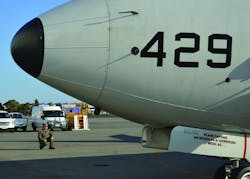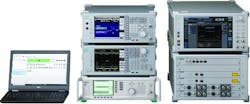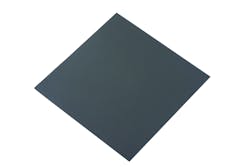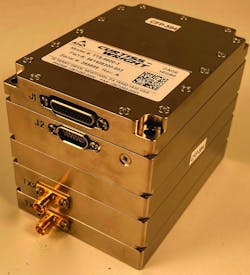NASHUA, N.H. - Radio frequency (RF) and microwave technologies for military and aerospace applications like communications, surveillance, and sensors are being asked to do more in an increasingly cluttered spectrum while end-users ask for smaller size, weight, power consumption, and cost (SWaP-C), as well as the ability to perform in harsh environments.
Not only that, but the military’s desire for open-architecture, vendor-neutral systems like the Sensor Open Systems Architecture (SOSA) standard are driving trends in the RF and microwave applications, points out Rodger Hosking, vice president of embedded computing and signals intelligence expert Pentek Inc. in Upper Saddle River, N.J.
“Shrinking dimensions of new RF and microwave components and the advent of system-on-chip acquisition and FPGA [field-programmable gate array] devices like RFSoC support small-form-factor subsystems for radar, countermeasures, and communications,” Hosking says. “Since many of these use phased-array antennas, signal channel counts are increasing, thus favoring simpler and shorter connections within the housings. The strong open-architecture directives from the DOD [the U.S. Department of Defense] to spur vendor interoperability, lower acquisition costs, and shorter cycles for new technology insertion led directly to the SOSA initiative.”
The Open Group, which oversees SOSA standards, comprises more than 750 companies worldwide. SOSA aims to reduce time, risk, and costs for development cycles, systems integration, sustainment, and modernization. In addition, the group aims to increase commonality and reuse, support incremental improvements, mitigate obsolescence, and isolate the effects of change.
Software and FPGA IP development tools are becoming more critical in system design efforts,” Hosking says. “Vendors who provide a high initial level of basic functionality for system interfaces, signal acquisition and generation, timing, and data formatting, along with the tools to customize the products for specific applications, offer significant advantages to mil-aero system integrators.”
Focus on 5G
Fifth-generation cellular telecommunications technology — better known as 5G — is influencing not only consumer devices but also how the military is fashioningMilitary experts will be able to use three segments of the electromagnetic (EM) spectrum, including low band frequencies lower that 1 GHz; mid band, which operates between 1 and 6 GHz; and high band, which operates between 24 and 300 GHz.
Currently, consumer 5G devices operate at 6 GHz and below. High band, also known as millimeter wave, allows for much faster data transfer rates, but requires for a clear area between devices and the tower as buildings or even rain can absorb or disrupt the signal.
“Certainly, the electronic device development to support 5G as well as the upcoming 6G has also positively impacted the RF and microwave with smaller, higher-frequency, more efficient devices,” says Paul Cook, director of missile systems and product line manager at Curtiss-Wright Defense Solutions in Ashburn, Va. “The 5G network is in review to be used instead of our traditional means of transmitting data but not all of the feasibility studies provide a positive solution to replace our current transmission solutions.”
The military also has unique wireless communications needs at the leading edge of the battlefield. While commercial telecommunications companies can put up towers in static urban, suburban, and rural environments, the constantly changing nature of the battlefield coupled with the constant threat of enemies trying to jam signals, adds significant difficulty.
“The 5G promise of seamless connectivity of wideband digital wireless service to any customer in any location satisfies a critical objective for military warfighters during an operation,” says Pentek’s Hosking. “Harnessing 5G technology by adding security encryption and distributing portable microcells in a combat zone is extremely attractive to defense organizations.”
Testing 5G compliance
This spring, Anritsu Co. in Allen, Texas, introduced the ME7803NR RF regulatory test and measurement system for regulatory compliance testing of 5G wireless communications systems.
At the core of the ME7803NR is the radio communications test station MT8000A, which simulates a 5G NR base station. The system also integrates the MT8821C radio communication analyzer operating as an LTE anchor, as well as a combination of the MS2840A/MS2850A spectrum analyzers/signal analyzers, MG3710E vector signal generator, and mg3694c signal generator.
The system makes its measurements using 5G NR NSA mode call connections. Additionally, it can test for spurious and interference, which fills a test void for many companies. A built-in calibration function changes the connection configuration, for improved measurement stability and measured value reliability.
Measurement efficiency and quality of 5G terminals come from the easy-to-operate GUI. In addition to evaluating RF performance of 5G UE to ensure they comply with leading regulatory requirements, the ME7803NR easily determines if radio waves are being used efficiently.
RF and microwave applications
Curtiss-Wright’s Cook says that systems designers are looking for 5G capability in new RF and microwave technology. “That again has resulted in a perfect fit to replace our current infrastructure.” Cook notes that the Curtiss-Wright TTS-9800-2 series multimode transmitter uses 5G technology while providing high RF power efficiency.
“The TTS-9800-2 multi-band transmitter took advantage of the device breakthroughs in the commercial, 5G market to provide a transmitting platform that operates in three frequency bands, provides the latest multipath compensation techniques,” Cook says. This would not have been possible 10 years ago without the various RF devices developed for 5G.”
The TTS-9800-2 is suitable for flight test instrumentation, unmanned aerial vehicle (UAV) communications, spacecraft instrumentation, and launch vehicle telemetry. With multiband functionality (L, S, and C-Bands), device is frequency agile, operating at 1435.5 to 1534.5 MHz, 1750.0 to 1855.0 MHz; 2200.0 to 2400.0 MHz; 4400.0 to 4940.0 MHz; and 5091.0 to 5250.0 MHz.
Pentek’s model 6353 is an 8-channel RFSoC transceiver sub-system, housed in a small rugged chassis with 5 GS/sec A/D converters and 10 GS/sec D/A converters. It is designed for extreme environments, like an antenna mast, aircraft pod, or unmanned vehicle. Digitized signals flow over dual 100 gigabit Ethernet optical cables to a host processor at rates up to 24 gigabytes per second.
“Pentek’s model 5553 SOSA-aligned 3U VPX RFSoC Processor offers the same Gen 3 RFSoC device as above,” Hosking says. “It is extremely well-suited for phased-array radar and electronic warfare applications and supports synchronization across all channels and multiple boards.”
Absorbing microwaves
Laird R&F Products in Carlsbad, Calif., has developed a series of lightweight and corrosion-resistant microwave absorbers that perform reliably at low frequenciesLaird’s new RF-LW series of absorbers have higher permeability and permittivity than standard magnetic fillers. Permittivity refers to the ability of a substance to store electrical energy in an electric field.
“Historically, absorbing materials used at low frequencies have been thick and heavy and vulnerable to corrosion,” says Rick Johnson, aerospace and defense director at Laird R&F Products. “To address this issue, we investigated new metal alloys, particle morphology and processing parameters to develop particles with higher magnetic permeability and permittivity than traditional iron fillers. The result is the RF-LW series of absorbers, which are resistant to corrosion and thinner and lighter than traditional iron-loaded materials.”
Johnson explains that the RF-LW series of absorbers is the result of Laird looking to improve on the microwave absorbing technologies that have been around since early in the Cold War.
The RF-LW series comes in three materials, including nitrile, fluorosilicone, and silicone elastomers. According to Laird, nitrile elastomers offer fuel and fluid resistance and are effective on military aircraft and naval ships across a wide range of temperatures — from -65 to 280 degrees Fahrenheit.
Fluorosilicone elastomers perform reliably in high-temperature applications — up to 475 degrees Fahrenheit. These rugged elastomers also withstand exposure to harsh substances such as jet fuel and deicing fluids.
Silicone elastomers are most effective within electronics housings, whereas the nitrile and fluorosilicone elastomers are designed for use on the outside of military vehicles and equipment.
In addition, Laird R&F Products can assess absorber performance across frequencies and angles of incidence at various thicknesses and weights. Then, the Laird R&F Products team can optimize absorber design and performance.
Internal interference
In 2020, Laird’s Johnson told Military & Aerospace Electronics that manufacturers are also tackling issues related to internal high frequency electromagnetic interference.
Defending warfighters
When it comes to trends in RF and microwave technologies, the mil-aero industry is tasked not only with protecting equipment from RF and microwave interference and utilizing the spectrum to gain an advantage over adversaries, but to keep warfighters out of harm’s way.
For the last two decades, improvised explosive devices (IEDs) have proved to be a formidable weapon that allows adversaries to U.S. and allied forces to cause casualties without facing down better equipped and trained warfighters.
Often, IEDs are detonated by using radio frequencies from a distance. The explosives are also generally hidden from plain view, so actively jamming radio frequencies is needed. The DOD continues to rely on electronic warfare experts at Northrop Grumman Corp., based in Falls Church, Va., to provide Joint Counter-Radio-Controlled Improvised Explosive Device Electronic Warfare (JCREW) increment one block one (I1B1) systems for American and allied forces.
The JCREW I1B1, formerly known as JCREW 3.3, is the first-generation system that develops a common open architecture across all three capabilities and provides protection with RF jammers for worldwide military operations.
The system jams a wide range of IEDs and creates a protective barrier around Marine Corps infantry and their equipment while minimizing disruption to friendly communications systems.
About the Author
Jamie Whitney
Senior Editor
Jamie Whitney joined the staff of Military & Aerospace Electronics in 2018 and oversees editorial content and produces news and features for Military & Aerospace Electronics, attends industry events, produces Webcasts, and oversees print production of Military & Aerospace Electronics.




